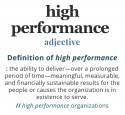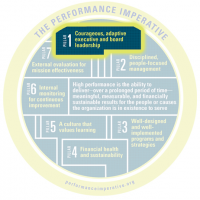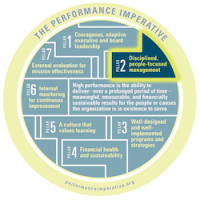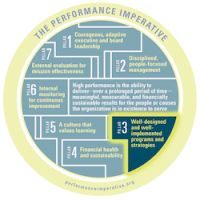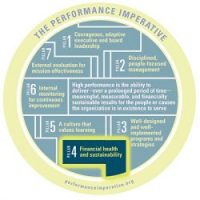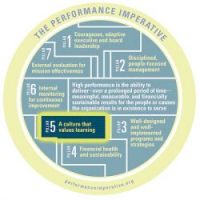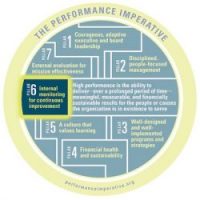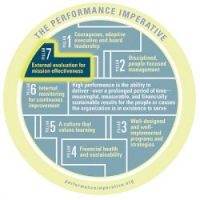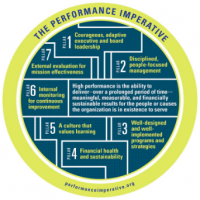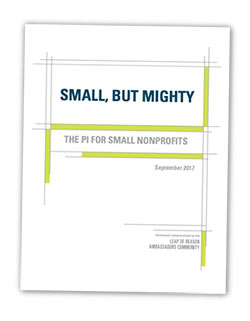Are you an executive director who—in addition to running your organization—also handles marketing, program design and delivery, fundraising, board meetings, and at times, often late at night, wonders how to keep the lights on and make payroll?
Or do you lead a financially stable organization but are ever mindful that federal, state, and/or local budget shortages may lead to fewer resources and increased demand?
Or do you run a well-oiled machine but know you could achieve more, and do better, for the people you serve?
Or perhaps you know other nonprofit organizations that have implemented continuous quality improvement strategies and wonder how they can possibly find the time to do so?
You’re in good company. Thousands of organizational leaders face the same questions every day. And while there are no silver bullets, there are specific, proven steps to help move your organization forward.
This short introductory document provides accessible entry points and specific tips for how the Performance Imperative (PI), a framework for social-sector excellence, can be useful to nonprofit leaders with organizational budgets of $100,000 and above. We hope it serves as a guiding framework, whether you’re new to this journey or already on a path to continuous improvement. And, we’re confident that over time, your efforts will result in improved benefits for the people and causes you serve.
The Leap Ambassadors—a community of nonprofit leaders, funders, consultants, and researchers—who collaboratively developed the Performance Imperative, suggest you view your efforts toward high performance as an intentional journey. It’s lengthy, it’s cumulative, and it’s powerful. Even starting with only one element of high performance can lead to reflection, planning, and action that leads to another, and overtime, many. Similar to running a marathon or losing weight, which takes dedication, practice, and hard work, making a commitment to improvement is the first step toward great results.
We have found that high performance is less about specific decisions and more of a context and framework to approach decision-making. Many organizations and leaders have found that strengthening their organization’s performance eventually embraces every component of their work, every aspect of their organizational culture, and every function in the organization. While that may sound overwhelming, it needn’t be.
As William Attaway, Lead Pastor, Southview Community Church said, “If you think ‘We’re too small, we don’t have the resources, we don’t have the time,’ my response is, ‘Well, you’ve got to want to. You’ve got to want to do this. You’ve got to want to get better. Do you want to get better? Do you want to improve? Do you want to be more effective in your mission? If you do, then this is for you.’”
The time is now. The road may be long, but the journey to high performance is for nonprofits of all sizes and it’s worth the trip! The benefits begin from the first steps and are cumulative over time.
What’s the Benefit?
If your situation is similar to ours, you’re increasingly asked to “demonstrate” performance. Donors and funders want assurance that you’re delivering results, not just planning and running well-intentioned activities. Or perhaps this push for results is coming from your board members and professional colleagues. In an ideal world, the drive for results comes from you, the nonprofit leader.
The Performance Imperative was collaboratively developed to help nonprofit leaders and their supporters meet this challenge. While it was initially conceived and written with larger nonprofits in mind ($3M+ in annual revenue), we believe it is just as valuable for smaller organizations whose leaders are committed to understanding what their organization is currently achieving and then continuously improving upon those results.
How Small Is Small?
We recognize the enormous differences in capacity between organizations with an annual budget of $100K and those with a $3M budget. Yet we believe that dedicated leaders of organizations with revenue between $100,000 and $3M (approximately 88% of the nonprofit sector, according to the Urban Institute’s Nonprofit Sector in Brief 2015), can skillfully use the Performance Imperative to improve the quality and benefits of their work.
Smaller organizations have certain advantages over their larger colleagues. They often maintain close connections to the people they serve and the broader community. Perhaps because of these relationships, their staff is deeply committed to their work, often making the organizations surprisingly resilient. Tactically, smaller nonprofits can get everyone in one room to learn and come to agreement more easily. This allows for more nimble decision-making, especially when there is a guiding framework.
Seeking a North Star
We all know that roadmaps are antiquated as soon as printed, which is why most of us enthusiastically jumped on the GPS bandwagon. The Performance Imperative serves a similar purpose: It’s a guiding framework for the journey to high performance. Like your GPS, the Performance Imperative offers optional routes, all leading to the ultimate goal of mission improvement. Many organizations use the Performance Imperative as a North Star and are seeing great results.
The Performance Imperative’s definition of high performance and its seven pillars make a deliberate approach to quality more than compelling; they make it both thought-provoking and actionable no matter how young—or old—the agency. Examples include:
- SHALVA, a domestic abuse agency in Chicago with an annual budget of approximately $1M, has made great progress in gaining clarity and direction based on elements of the Performance Imperative. Executive Director Carol Ruderman says, “I knew we were doing amazing work at SHALVA and recognized there had to be a better way to capture the impact of our work and clarify our messaging. I also knew there had to be opportunities for improvement that we couldn’t see ourselves.”With dedicated leadership from the board president and the executive director (Pillar 1), SHALVA raised funds to engage a consultant to help them refine their work, all timed to its 30th anniversary. They engaged staff and key board members to revisit the mission and vision and develop a theory of change that helped them prioritize both their services and their structure to achieve mission (Pillar 3). Understanding that organizational culture can impede or support organizational structure and change management, Ruderman has intentionally built a culture that values learning (Pillar 5). Specifically, she has taken on the challenge of setting expectations with everyone in the organization for consistently collecting and using information and data, even though it is unprecedented. SHALVA is establishing and improving upon key metrics, based on their learning (Pillar 6).What’s the result? “With guidance from our consultant, the Performance Imperative was just the framework and support we needed. We are halfway through our three-year plan. Our messaging is now consistent, clear, and being used in our fundraising efforts, education programs, and among our team. We are beginning to capture real data to show outcomes, not just outputs, and our whole team now understands the difference. We are definitively still at the beginning of our journey. But as I look back, I am amazed at how far we have come and, as I look forward, excited about what I know we will accomplish,” she says.
- The City School, a small youth social justice nonprofit in Boston, knew that some of its students weren’t interested in college as a future pathway, but they didn’t have clear alternative destination or clear plan to get them there (Pillar 3). After creating a theory of change (Pillars 1 and 3), they added new intermediate and long-term outcome commitments and measures, specifically that their youth will become social justice leaders in their communities and complete at least two years of post-secondary preparation. To help youth achieve these outcomes, they extended core programming from eight weeks to two years (Pillar 3). These changes increased their participant-outcomes success rate from 11% in 2011 to 51% in 2016 (Pillar 6). This means that every year, 17 more youth are actively engaged in social justice leadership in their communities, and are implementing their individualized, financially sustainable two- to four-year post-secondary plans. The organization tangibly increased its results for the young people it served.
Where to Start?
Since the Performance Imperative is a framework for action that includes a definition of high performance and seven “pillars” (or integrated guidelines) that help organizations to achieve high performance, there are multiple entry points. No organization, large or small, can (or should) tackle all seven pillars at once. Even among the Leap Ambassadors there is little consensus on where to start. The reality is that it varies from organization to organization. However, we broadly support the recommendation that organizational leaders find modest, “bite-size” ways to begin the journey. With a mindset for improvement, it’s important make the decision to work toward high performance, start somewhere and celebrate incremental progress. The Performance Imperative is analogous to training for an athletic event: The whole body needs to be in shape, and it becomes so through a structured program that addresses strength, flexibility, speed, power, and a deep understanding of the event and how the body should engage. When and how you address each of those components can vary.
Consider one of the following pathways or choose your own entry point:
Start with the Definition of High Performance
Many organizations find a conversation about the definition of high performance a solid place to start:
“High performance is the ability to deliver—over a prolonged period of time—meaningful, measurable, and financially sustainable results for the people or causes the organization is in existence to serve.”
Consider questions, like these, to spark the discussion:
- Are we consistently delivering superior results over time?
- Are our results meaningful? How do we know?
- What do we measure? Are they the “right” things to measure for the people and causes we serve?
- Is our work financially sustainable? What is our total cost for what we do now? How might those costs change as we grow?
Chances are these discussions will uncover misalignment among participants and responses such as, “I don’t know.” We hope your response will be, “Well, let’s talk further and think about some ways to find out.”
Review the Performance Imperative as a whole and decide which pillar resonates as the greatest opportunity
No matter where you start, a first step might be to explore the Performance Imperative as a whole. This exploration can help you determine where you are already strong and where you could use some extra focus. Just don’t let the whole picture overwhelm you; understanding how the pieces fit together is part of your journey to high performance.
Start with Pillar 1 (Courageous, adaptive executive and board leadership) or Pillar 3 (Well-designed and well-implemented programs and strategies)
Some say, “Pillar 1, of course. For without courageous, adaptive executive and board leadership, you can’t do anything else.” Starting with leadership often leads to the need to clarify your “theory of change” (Pillars 1 and 3) and serves as the foundation for other improvements. A program’s theory of change may reside solely in the executive director’s head. It may not be documented or widely shared, which leads to inconsistent program delivery. As you investigate your theory of change and communicate it to staff and board, you may find that you would like to strengthen their skills and capacities to help you make better decisions and strengthen your program model (Pillar 3). From there, “A culture that values learning” (Pillar 5) may be the next step. Even the best-laid processes and strategies require the people carrying them out to be open to learning, change, and improvement.
Start with a unique challenge and look to the pillar that provides guidance for resolution
Sometimes momentum for change is already underway, especially if your organization is facing a significant challenge. In that case, it’s a good idea to start with priorities that emerge—those things that keep you up at night. This organization began with Pillars 1 and 3:
In 2011, a tiny youth dance nonprofit in Boston, BalletRox was facing structural and strategic challenges (Pillar 1). The organization ran chronic budget deficits (Pillar 4) and had no capacity to measure its program performance (Pillar 6). Gaining clarity around leadership and its theory of change (Pillars 1 and 3) enabled leaders to straighten out legal and structural challenges. The staff embraced internal monitoring practices for continuous improvement (Pillar 6). Soon, they won back grants lost during the challenging phase, gained new grants, and resolved their financial crisis. Over the next three years, their budget increased from $50,000 to $200,000. They have since won state-wide and national awards for the quality of their youth arts programming!
Note: As a small nonprofit, you can set External Evaluation for Mission Effectiveness (Pillar 7) aside, at least for now. Given the flexibility in where to begin the journey within the first six pillars, the Leap Ambassadors Community recommends implementing robust processes and systems across Pillars 1 through 6, prior to diving into Pillar 7. If small nonprofits decide that they have already built up the strength of the first six pillars and feel a level of certainty in investing the time and money for external evaluation, they should ensure that the first evaluation is formative, rather than summative. In other words, the evaluation should build measurement and learning into the process of informing program design, rather than solely looking at past program design and delivery to assess impact. Any external evaluation should provide a comprehensive plan for future learning and include opportunities for continuous improvement processes.
The opportunity for small nonprofits is great. Any entry point to the Performance Imperative, proactive or reactive, should ultimately lead to efforts for improving all pillars in an effort to move from the urgent to the important for results. While small nonprofits don’t have the capacity to improve all the pillars in a short period of time, addressing pillars in isolation may obscure the scope of possibilities of the Performance Imperative.
Note: Important barriers to entry are reduced by the fact that the Performance Imperative is an off-the-shelf, free, and high-quality framework. Nonprofits will find a rich set of tangible resources, stories, and videos at http://www.LeapAmbassadors.org.
If Not Now, When?
Now is a good time. Ideally, small nonprofit leaders will approach the Performance Imperative proactively; however, periods of crisis can also be a good starting point—particularly if what the nonprofit was doing is no longer working.
A small nonprofit with a staff of seven, lost four team members at the same time. They saw the Performance Imperative, and it “sent them over the edge.” But courageous leadership (Pillar 1) worked simultaneously on Pillars 2 and 4 (with two different consultants).
In another small nonprofit, all the nonprofit’s financial records were lost in the aftermath of a tragedy. In response, the organization’s board recruited a CFO who helped improve the organization’s financial management (Pillar 4).
There’s something in the Performance Imperative that will resonate with any nonprofit leader who wants to learn and improve, so start with a single pillar and start now. Know that the journey to high performance isn’t easy, but with each step, you’ll gain peace of mind that you are achieving results for the people or causes you are in existence to serve. And, the outputs from the process certainly make grant-writing and fundraising more successful, too! We hope you’ll find the Performance Imperative serves as a useful guide for your journey.
